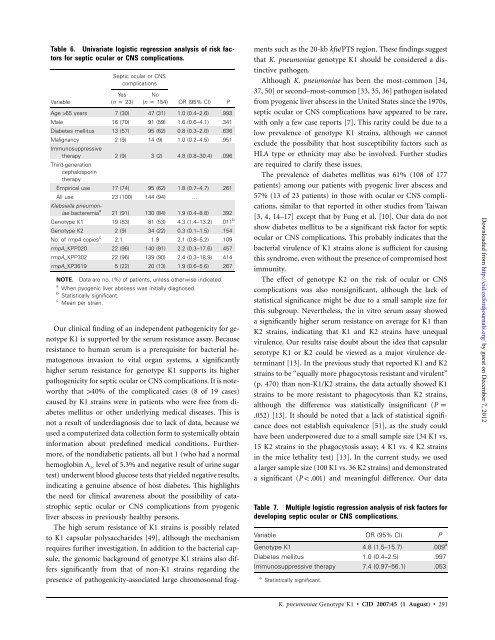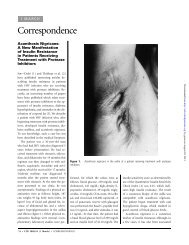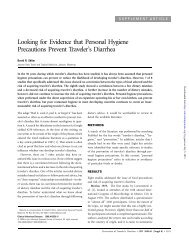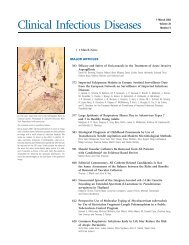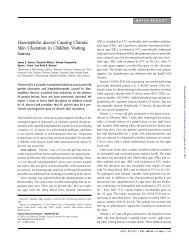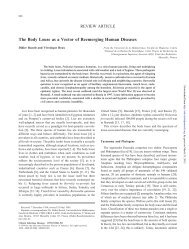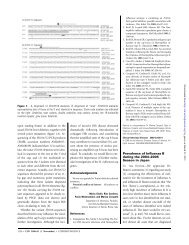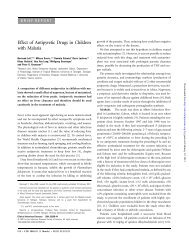Klebsiella pneumoniae - Clinical Infectious Diseases
Klebsiella pneumoniae - Clinical Infectious Diseases
Klebsiella pneumoniae - Clinical Infectious Diseases
Create successful ePaper yourself
Turn your PDF publications into a flip-book with our unique Google optimized e-Paper software.
Table 6. Univariate logistic regression analysis of risk factors<br />
for septic ocular or CNS complications.<br />
Variable<br />
Septic ocular or CNS<br />
complications<br />
Yes<br />
(n p 23)<br />
No<br />
(n p 154)<br />
OR (95% CI) P<br />
Age 165 years 7 (30) 47 (31) 1.0 (0.4–2.6) .993<br />
Male 16 (70) 91 (59) 1.6 (0.6–4.1) .341<br />
Diabetes mellitus 13 (57) 95 (62) 0.8 (0.3–2.0) .636<br />
Malignancy<br />
Immunosuppressive<br />
2 (9) 14 (9) 1.0 (0.2–4.5) .951<br />
therapy<br />
Third-generation<br />
cephalosporin<br />
therapy<br />
2 (9) 3 (2) 4.8 (0.8–30.4) .096<br />
Empirical use 17 (74) 95 (62) 1.8 (0.7–4.7) .261<br />
All use<br />
<strong>Klebsiella</strong> pneumon-<br />
23 (100) 144 (94) …<br />
iae bacteremia a<br />
21 (91) 130 (84) 1.9 (0.4–8.8) .392<br />
Genotype K1 19 (83) 81 (53) 4.3 (1.4–13.2) .011 b<br />
Genotype K2 2 (9) 34 (22) 0.3 (0.1–1.5) .154<br />
No. of rmpA copies c<br />
2.1 1.9 2.1 (0.8–5.2) .109<br />
rmpA_KPP020 22 (96) 140 (91) 2.2 (0.3–17.6) .457<br />
rmpA_KPP302 22 (96) 139 (90) 2.4 (0.3–18.9) .414<br />
rmpA_KP3619 5 (22) 20 (13) 1.9 (0.6–5.6) .267<br />
NOTE. Data are no. (%) of patients, unless otherwise indicated.<br />
a<br />
When pyogenic liver abscess was initially diagnosed.<br />
b<br />
Statistically significant.<br />
c<br />
Mean per strain.<br />
Our clinical finding of an independent pathogenicity for genotype<br />
K1 is supported by the serum resistance assay. Because<br />
resistance to human serum is a prerequisite for bacterial hematogenous<br />
invasion to vital organ systems, a significantly<br />
higher serum resistance for genotype K1 supports its higher<br />
pathogenicity for septic ocular or CNS complications. It is noteworthy<br />
that 140% of the complicated cases (8 of 19 cases)<br />
caused by K1 strains were in patients who were free from diabetes<br />
mellitus or other underlying medical diseases. This is<br />
not a result of underdiagnosis due to lack of data, because we<br />
used a computerized data collection form to systemically obtain<br />
information about predefined medical conditions. Furthermore,<br />
of the nondiabetic patients, all but 1 (who had a normal<br />
hemoglobin A 1c level of 5.3% and negative result of urine sugar<br />
test) underwent blood glucose tests that yielded negative results,<br />
indicating a genuine absence of host diabetes. This highlights<br />
the need for clinical awareness about the possibility of catastrophic<br />
septic ocular or CNS complications from pyogenic<br />
liver abscess in previously healthy persons.<br />
The high serum resistance of K1 strains is possibly related<br />
to K1 capsular polysaccharides [49], although the mechanism<br />
requires further investigation. In addition to the bacterial capsule,<br />
the genomic background of genotype K1 strains also differs<br />
significantly from that of non-K1 strains regarding the<br />
presence of pathogenicity-associated large chromosomal frag-<br />
ments such as the 20-kb kfu/PTS region. These findings suggest<br />
that K. <strong>pneumoniae</strong> genotype K1 should be considered a distinctive<br />
pathogen.<br />
Although K. <strong>pneumoniae</strong> has been the most-common [34,<br />
37, 50] or second–most-common [33, 35, 36] pathogen isolated<br />
from pyogenic liver abscess in the United States since the 1970s,<br />
septic ocular or CNS complications have appeared to be rare,<br />
with only a few case reports [7]. This rarity could be due to a<br />
low prevalence of genotype K1 strains, although we cannot<br />
exclude the possibility that host susceptibility factors such as<br />
HLA type or ethnicity may also be involved. Further studies<br />
are required to clarify these issues.<br />
The prevalence of diabetes mellitus was 61% (108 of 177<br />
patients) among our patients with pyogenic liver abscess and<br />
57% (13 of 23 patients) in those with ocular or CNS complications,<br />
similar to that reported in other studies from Taiwan<br />
[3, 4, 14–17] except that by Fung et al. [10]. Our data do not<br />
show diabetes mellitus to be a significant risk factor for septic<br />
ocular or CNS complications. This probably indicates that the<br />
bacterial virulence of K1 strains alone is sufficient for causing<br />
this syndrome, even without the presence of compromised host<br />
immunity.<br />
The effect of genotype K2 on the risk of ocular or CNS<br />
complications was also nonsignificant, although the lack of<br />
statistical significance might be due to a small sample size for<br />
this subgroup. Nevertheless, the in vitro serum assay showed<br />
a significantly higher serum resistance on average for K1 than<br />
K2 strains, indicating that K1 and K2 strains have unequal<br />
virulence. Our results raise doubt about the idea that capsular<br />
serotype K1 or K2 could be viewed as a major virulence determinant<br />
[13]. In the previous study that reported K1 and K2<br />
strains to be “equally more phagocytosis resistant and virulent”<br />
(p. 470) than non-K1/K2 strains, the data actually showed K1<br />
strains to be more resistant to phagocytosis than K2 strains,<br />
although the difference was statistically insignificant (P p<br />
.052)<br />
[13]. It should be noted that a lack of statistical significance<br />
does not establish equivalence [51], as the study could<br />
have been underpowered due to a small sample size (34 K1 vs.<br />
15 K2 strains in the phagocytosis assay; 4 K1 vs. 4 K2 strains<br />
in the mice lethality test) [13]. In the current study, we used<br />
a larger sample size (100 K1 vs. 36 K2 strains) and demonstrated<br />
a significant ( P ! .001)<br />
and meaningful difference. Our data<br />
Table 7. Multiple logistic regression analysis of risk factors for<br />
developing septic ocular or CNS complications.<br />
Variable OR (95% CI) P<br />
Genotype K1 4.8 (1.5–15.7) .009 a<br />
Diabetes mellitus 1.0 (0.4–2.5) .997<br />
Immunosuppressive therapy 7.4 (0.97–56.1) .053<br />
a Statistically significant.<br />
K. <strong>pneumoniae</strong> Genotype K1 • CID 2007:45 (1 August) • 291<br />
Downloaded from<br />
http://cid.oxfordjournals.org/ by guest on December 7, 2012


